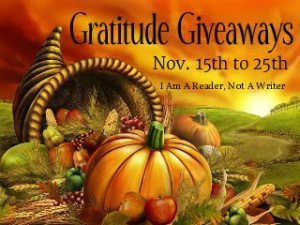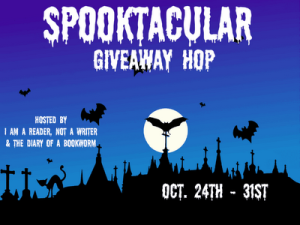Meredith Allard's Blog, page 39
December 10, 2012
Gift Card Giveaway Hop
Welcome to the Gift Card Giveaway Hop! This hop runs from December 11 to the 17th. Thanks to I Am a Reader, Not a Writer and Sweeping Me for hosting. I’ll be giving away one $15 gift certificate to either Amazon.com or BN.com (your choice) for two lucky winners.
You must be a follower of this blog to enter. You can gain extra entries with the following:
Following this blog +1
Follow me on Twitter +1
Like The Copperfield Review on Facebook +1
Friend me on Goodreads +1
Friend me on Facebook +1
The extra entry options are available on the right sidebar of this page. Then fill out the form below and you’re entered.
[contact-form]
There are over 100 great websites involved in this hop. Check here to see what other wonderful items you can win.
Filed under: Giveaways Tagged: Gift Card Giveaway, Giveaways, I am a Reader Not a Writer

November 26, 2012
Gratitude Giveaway Winners
Thank you to everyone who participated in the Gratitude Giveaway. Over 100 people entered. Here are the winners:
E-Books:
1. Sandy Castrain
2. Thomas Spector
Paperback:
1. Trish Y.
Amazon.com Gift Card:
1. Blair Teal
I’ll be back on December 11 for the Gift Card Giveaway. That one should be fun!
Filed under: Giveaways Tagged: Giveaways

November 14, 2012
Gratitude Giveaway
Welcome to the Gratitude Giveaway Hop! This hop runs from November 15 to November 25. Thanks to I Am a Reader, Not a Writer for hosting.
I’ll be giving away two e-books (either Her Dear & Loving Husband or Her Loving Husband’s Curse–your choice). I also have one paperback copy of either Her Dear & Loving Husband or Her Loving Husband’s Curse to give away. If you’re not familiar with the stories, check here. There’s also a $10 gift certificate to either Amazon.com or BN.com (your choice) for one lucky winner.
You must be a follower of this blog to enter. You can follow any way you choose (e-mail, Networked Blogs, or WordPress). Fill out the simple form below and you’re entered. That’s it!
[contact-form]
There are over 200 great websites involved in this hop. Check here to see what other wonderful items you can enter to win.
Filed under: Giveaways Tagged: Giveaways, Gratitude Giveaway, I am a Reader Not a Writer

November 1, 2012
Winners of the Spooktacular Giveaway
There were over 200 entries for the Spooktacular Giveaway. Thanks to everyone for participating! Here are the winners:
E-Books:
1. Amy Layas
2. Jessica W.
3. Timmie Tee
4. Mona O.
5. Macy
Paperbacks:
1. georgiegirl
2. Deanna
3. Mahnma J.
Amazon Gift Card:
1. Lahalia S.
I’ll be back on November 15 for another giveaway. Hope to see you then!
Filed under: Giveaways Tagged: Giveaways, Spooktacular Giveaway Hop

October 22, 2012
Spooktacular Giveaway Hop
Welcome to the Spooktacular Giveaway Hop! This hop runs from October 24th to October 31. Thanks to I Am a Reader, Not a Writer and The Diary of a Bookworm for hosting.
I’ll be giving away five e-books (either Her Dear & Loving Husband or Her Loving Husband’s Curse–your choice). I also have three paperback copies of either Her Dear & Loving Husband or Her Loving Husband’s Curse to give away. If you’re not familiar with the stories, check here. There’s also a $10 gift certificate to either Amazon.com or BN.com (your choice) for one lucky winner.
You must be a follower of this blog to enter. You can gain extra entries with the following:
Following this blog +1
Follow me on Twitter +1
Like The Copperfield Review on Facebook +1
Friend me on Goodreads +1
Friend me on Facebook +1
The extra entry options are available on the right sidebar of this page. Then fill out the form below and you’re entered. Don’t forget to let me know if you’d prefer Her Dear & Loving Husband or Her Loving Husband’s Curse.
[contact-form]
There are over 400 great websites involved in this hop. Check here to see what other wonderful items you can win.
Filed under: Giveaways, Her Dear & Loving Husband, Her Loving Husband's Curse Tagged: Giveaways, Her Dear, Her Loving, I am a Reader Not a Writer

September 28, 2012
Have I Said How Much I Love Writing About History?
In case you can’t tell, I love history. I think my interest started in high school when I had a cute young guy as my history teacher—I made sure to pay extra special attention to him in class. But my interest in history outlasted my 10th grade year, and in college I even considered becoming a history major. I’m fascinated by history because, though we can look back to see how the pieces fit to create the picture of who we are today, there is also a sense of “The more things change, the more they stay the same.” I’m always amazed to learn about these people from the past who on the surface seem so different from us today—in their dress, their speech, their beliefs, their scientific knowledge—and yet they aren’t at all different from us in their hopes and dreams.
I remember when I decided to write historical fiction. I had seen Ken Burns’ The Civil War documentary on PBS (this was way back in the old-timey days of the 1990s), and from watching that series came an idea about the son of a southern planter who goes to fight for the Union during the war. My earliest goal as a writer was to become a screenwriter, and I did study a bit of screenwriting and film in college, so I tried the idea out as screenplay. I got as far as page ten before I realized that the blueprint of the screenplay wasn’t enough for me—I wanted to describe the details, what the characters were thinking and feeling, what they were wearing, what the room they were standing in looked like. The only way I could do that, I thought, was to write the story out as a novel. I began writing My Brother’s Battle in 1994, and I finished it about two years later. I’ve been writing historical fiction ever since.
There is something fulfilling about writing historical fiction. Historical fiction helps to make history more palatable for those who might be bored by nonfiction accounts. In these fictional snapshots, I can take one moment in time and flesh it out, add characters, both real and imagined, show their dress, their manners, and the events that were happening then. Research is an important part of the process, and I’m just odd enough to enjoy searching for the information I need to help me tell the story.
For Her Dear & Loving Husband, I wrote about Salem in the Massachusetts Bay Colony during the witch hunts in 1692. What a sad moment in early American history—the false accusations, the coercions into confessions to crimes the victims didn’t commit, the dungeons, the executions. How could this happen? How could neighbor turn against neighbor? Friend against friend? Husband against wife? To this day, we still don’t know the answer. For Her Loving Husband’s Curse, I delved into the forced removal of the Cherokee on the Trail of Tears. Book Three also has an historical background, though I don’t want to say what it is just yet (I will say there is a hint of it in Book Two). Through writing historical fiction, I have been able to imagine life in Biblical Jerusalem as well as life in New York City in the 1910s. For someone who loves history as much as I do, the opportunity to write about these different periods, or about any historical period, is a blessing.
Have I said how much I love writing about history? Sharing these moments in time with others is one of my great joys, and through historical fiction I hope I can help others develop their own love for history.
Filed under: Writing Tagged: writing, writing historical fiction

September 21, 2012
Writing About Vampires
With Halloween not so far away (I’m already ready to put out my Halloween decorations), I’ve been thinking a lot about vampires.
When I decided to write my first vampire novels with the Loving Husband Trilogy, I realized I knew very little about vampire myths and legends. But do you have to do research to write about vampires, I wondered? Since vampires are imaginary creatures, I thought there wouldn’t be much studying I needed to do to write Her Dear & Loving Husband. The vampires I would be writing about are products of my creation, and I didn’t need to read books to understand them.
Still, being a curious person, I had a lot of questions. Where did vampire stories come from? I thought Bram Stoker’s Dracula was the beginning of the craze, but it turns out he had been inspired by stories of the undead too. In fact, vampire legends have been around for as long as there have been people to tell them. In earlier years, people explained whatever needed explaining through supernatural beliefs. If good things happened it was because of good spirits, and if bad things happened it was because of evil ones. In the years before science could explain medical oddities—like why some people sweat or cry blood or how someone could stop breathing and “come back to life”—people would say they were possessed by evil spirits. They had come back from the dead and they were to be feared. Stories about dead friends, neighbors, and family members who had come back to life circulated throughout villages, beginning our fascination, and our fear, of vampires. Societies all over the world have some stories in their legends and folklore about the undead. I had some fun taking what I learned and putting it into the classroom scenes in Her Loving Husband’s Curse where James teaches a vampire literature class.
For those of us writing vampire stories today, we have the freedom to create our preternatural characters however we wish. The possibilities are endless. As I considered the vampires for the Loving Husband Trilogy, I decided I would stick mainly to conventional ideas. James Wentworth, the vampire protagonist in the stories, sleeps by day and lives by night. He’s immortal and will stay looking thirty years old forever. He drinks blood. He has to learn how to live among humans without revealing his true nature because he knows how people can react when they’re confronted by things they don’t understand. As for garlic bulbs and signs of the cross, well, those are just Eastern European legends after all. And if you can live forever, I don’t see how some garlic can hurt you, though it might give you bad breath.
I had never been into the paranormal/urban fantasy genre before. As someone who wrote historical fiction, which is based on fact, I didn’t think I could enjoy writing about such imaginary, fantastical characters. But once I allowed myself to try it, I realized I love writing vampire novels because I can mold the vampire legend in my own way. If you’re continuing on the journey with James and Sarah in 2013 (around March, I’d say), you’ll see exactly what I mean. Geoffrey (and Olivia) have a few vampire truths for James to learn in the third and final installment.
By stepping out of my comfort zone, by allowing myself to explore a genre I had never considered before, I had a whole paranormal/fantasy world open up for me. More than anything, I have been able to spend the last three years with characters, namely James and Sarah Wentworth, who are near and dear to my heart. And I’m glad I still have one more story to share with them.
Filed under: Her Dear & Loving Husband, Her Loving Husband's Curse Tagged: Her Dear & Loving Husband, Her Loving Husband's Curse, paranormal, vampires

September 14, 2012
Paranormal Romance? Urban Fantasy? Historical Fiction? All of the Above?
I still don’t know exactly how to classify the novels from the Loving Husband Trilogy. Sounds funny, that statement, especially since Her Dear & Loving Husband has been out since April 2011 and now I’m working on the third and final book in the series. I remember when I became familiar with the genre Urban Fantasy last summer. Not too swift for someone who writes about vampires, right? I’m not sure how the term escaped my notice. I had heard it before, certainly, but for me the term Urban Fantasy conjures images of a futuristic city—like the Jetsons with their flying saucers and talking toasters. Since I don’t read novels that fit into the science fiction/fantasy genre, I didn’t pay much attention to the label Urban Fantasy.
Before, my best guess for the genre of the Loving Husband Trilogy was Paranormal Romance, and yet I was never entirely comfortable with that label. I have nothing against romances; in fact, I love them. But for my vampire James Wentworth and the human woman he loves, Sarah Alexander, I wasn’t sure the romance genre fully described their story. James and Sarah’s love, how it grows from tentative caring to passionate connection, is a major part of their story. And James is a vampire, which fits in nicely with the supernatural aspect of Paranormal Romance. But the romance, while important, isn’t the only facet of the novel. I know from several romance novelists that romance novels tend to follow a specific formula. I’m not so good at following formulas, so I wasn’t sure what romance readers would think of the books.
Then I began reading Paranormal Romance blogs, and I saw various discussions about Urban Fantasy versus Paranormal Romance. After some research, I found out that Twilight and the Harry Potter books fall into the genre of Urban Fantasy. How did this affect how I viewed my own books? I found that paranormal characters are welcome in Urban Fantasy. Check. I found that in Urban Fantasy there is a coexistence between human and paranormal characters. Check. In Urban Fantasy the human learns of the existence of the paranormal. Check. In Urban Fantasy there can be romance. Double check. There is also emphasis on backstory, historical settings, and the characters may have tragic pasts. Check, check, check. Salem, Massachusetts doesn’t quite qualify as a city, but otherwise we’re on the right track here. And since Her Dear & Loving Husband is book one in a trilogy that features the same characters, that further qualifies James and Sarah’s story as an Urban Fantasy. Who knew?
And yet even Urban Fantasy doesn’t cover everything about the Loving Husband Trilogy. The books can also be classified as Historical Fiction, and no one was more surprised than me when I started seeing comments from reviewers calling the novels thrillers. A couple of people even put the books into the horror genre–James is a vampire, after all. I had the hardest time choosing categories for the novels on Amazon and Smashwords because so many genres seemed to fit.
What a realization, that Her Dear & Loving Husband fits into a genre–Urban Fantasy–I wasn’t even familiar with. I think that’s a pretty neat trick. I can’t wait to write my next book after I finish the Loving Husband Trilogy to find out what genre it belongs to.
Filed under: Her Dear & Loving Husband, Her Loving Husband's Curse, Writing Tagged: Her Dear & Loving Husband, Her Loving Husband's Curse, historical fiction, paranormal romance, urban fantasy

August 31, 2012
Thank You For an Amazing Summer
This time of year is always a shock to my system. After 2 ½ months of summer days where I can pretend I’m a full-time writer, I fall into the end of August like I’ve tripped into a vat of cold water. I love my work, but it takes a couple of weeks to get back into the routine of having a day job.
I have many reasons to be grateful for this past summer. In early June, sales of Her Dear & Loving Husband slowed, so to shake things up I set the price to free on Smashwords. Over the next two weeks, the free price filtered out to BN, iTunes, Sony, and then around June 20th Amazon caught onto the free price. Over the next four weeks, Her Dear & Loving Husband was downloaded over 100,000 times from Amazon and about 20,000 times from BN. Her Dear & Loving Husband had the honor of being number one on the Amazon free historical fiction and free literary fiction charts for about a week. I still have the screenshot of Her Dear & Loving Husband next to Charles Dickens’ A Tale of Two Cities on the best-seller list.
Now that the book is no longer free, it continues to sell at a much faster rate than it did before the free promotion. I changed the categories from historical and literary to occult and vampire-romance because I thought that would help keep the book visible to potential readers who dig vampires. Someone who has read and enjoyed Deborah Harkeness’ A Discovery of Witches might also like Her Dear & Loving Husband, and this way they can find it. Now both Her Dear & Loving Husband and Her Loving Husband’s Curse are on the paid occult best seller lists. At this exact moment they’re numbers 15 (HDLH) and 20 (HLHC). How did being free help sales? Before the book was free in June, I’d sell anywhere from 20-80 copies a month. If I sold 30 copies a month I was thrilled because that meant one person a day was buying. In the month of August nearly 4000 copies of the books sold—and that’s just on Amazon. Thank you.
It isn’t only the rise in sales that made this a great summer. Since July, the number of messages I’ve been receiving from readers has increased exponentially. Whether the messages are from my Contact Me page, comments on the posts, e-mails, Facebook, Twitter, from wherever—I love them all. As much as I love books, I have never once written to an author to tell her I liked her work. That a reader would take time from her busy day to write a review or send me a note about how much she loves James and Sarah means the world to me. I’ve received some of the loveliest messages any author can hope for.
One of the funniest things that happened to me happened just yesterday. I was on my Amazon Author Central page adding some information for the new historical novels I released, and out of the corner of my eye I spotted my name at the bottom of the screen. I looked to see what it was, and it was a note on a message board asking when Book Three of the Loving Husband Trilogy was going to be out! I wasn’t sure if, as the author, I should respond, but I figured hey, who knows the answer to that question better than me? Right now, the best I can say is early 2013—probably around March. I’m working on it as quickly as I can because I know readers are eager, but at the same time I don’t want to rush. The ending for James and Sarah has to be a good one. I want readers to be glad they stuck around.
Finally, Wednesday night, I was able to publish My Brother’s Battle, a Civil War novel I originally published in 2000 through Xlibris. I accomplished my summer’s main goal, which was to revise, edit, and release the three historical novels I had written in years past. I’ll have more to say about those soon, but for now they’re available for free on Smashwords, iTunes, and soon BN. You can find the links to download the free books on the right. While they’re not at all like the Loving Husband Trilogy (these characters are fully human), I hope you still like them.
Thank you, thank you for an amazing summer. I’m not sad to see summer end, though. There are many more historical journeys we can travel together, not to mention the release of Book Three in 2013. This is a fun, crazy ride. You are all genuinely appreciated.
Filed under: Her Dear & Loving Husband, Her Loving Husband's Curse, News, Tidbits Tagged: Amazon, BN, Her Dear & Loving Husband, Her Loving Husband's Curse

August 30, 2012
Winners of the Feed Your Reader Giveaway
Over 200 people entered the Feed Your Reader giveaway. Thank you to everyone who entered. Here are the winners:
1. Doodle Bug
2. Natasha D.
3. Stephanie S.
4. Lori M.
5. Debbie P.
6. Barbara A.
7. BeachHouseWrite
8. DJ
9. Trace
10. Rebecca J.
I’ll be back with the Halloween Spooktacular Giveaway in October. Should be fun!
Filed under: Giveaways







